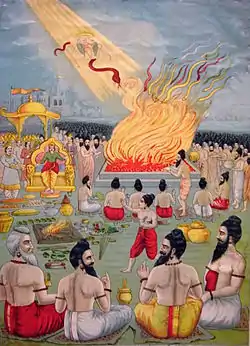Naga Panchami
Naga Panchami is a day of traditional worship of Nagas or snakes observed by Hindus throughout India, Nepal, and other countries where Hindu adherents live.[2][3][4] The worship is offered on the fifth day of bright half of lunar month of Shravana (July/August), according to the Hindu calendar. Some Indian states, such as Rajasthan and Gujarat, celebrate Naga Panchami on the dark half (Krishna Paksha) of the same month.[5] As part of the festivities, a Naga or serpent deity made of silver, stone, wood, or a painting of snakes is given a reverential bath with milk and their blessings are sought for the welfare of the family.[3] Live snakes, especially cobras, are also worshipped on this day, especially with offerings of milk and generally with the assistance of a snake charmer.[6]
| Nāga Panchamī | |
|---|---|
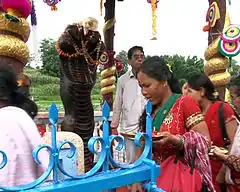 A Statue of Naga being worshiped on Naga Panchami | |
| Also called | Naaga Pujaa |
| Observed by | Hindus |
| Type | Religious, India and Nepal |
| Observances | Worshipping images or live Cobra. |
| Date | Fifth day (Panchami) of the month of Shravana month of the Lunar calendar |
| 2020 date | 25 July (Sat)[1] |
| Part of a series on |
| Hinduism |
|---|
 |
|
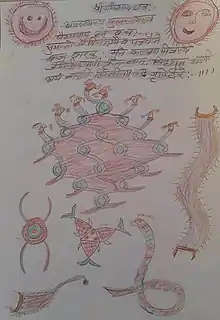
In the Mahabharata epic, the sage Astika's quest to stop the sacrifice of serpents (Sarpa Satra) of King Janamejaya, is well known, as it was during this sacrifice that the Mahabharata as a whole was first narrated by the sage, Vaisampayana.[7] This yagna sacrifice was performed by Janamejaya to decimate the race of Nagas through killing every snake in existence to avenge the death of his father Parikshita due to the deadly bite of Takshaka, the king of the snakes. The day that the sacrifice was stopped, due to the intervention of the Astika, was on the Shukla Paksha Panchami day in the month of Shravana. That day has since been observed as Naga Panchami.[8]
Etymology
Panchami is the fifth day among the fifteen days of the moon's waxing and/or waning. This special day of the serpent worship always falls on the fifth day of the moon's waning in the Lunar Hindu month of Shravana July/August. Hence this is called Naga Panchami (Naga: cobra; or simply, serpent).[9]
Legends
There are many legends in Hindu mythology and folklore narrated to the importance of worship of snakes.[10]
According to Hindu Puranic literature and the Mahabharata, Kashyapa, son of the universal creator Lord Brahma, married two daughters of Prajapati, Kadru and Vinata. Kadru then gave birth to the race of Nagas, while Vinata gave birth to Aruna, who became the charioteer of the sun god, Surya, and also birth to the great eagle Garuda, who became the carrier of Vishnu.[11]
Naga Panchami is also a day when Akhara, traditional Indian wrestling gyms, hold special celebrations to honor the mystical symbolism of the snake as a symbol of virility and kundalini energy.[6]
History
Indian scriptures such as Agni Purana, Skanda Purana, Narada Purana and the Mahabharata give details of history of snakes extolling worship of snakes.[10]
In the Mahabharata epic, Janamejaya, the son of King Parikshita of the Kuru dynasty was performing a snake sacrifice known as Sarpa Satra, to avenge for the death of his father from a snake bite by the snake king called Takshaka.[12] A sacrificial fireplace had been specially erected and the fire sacrifice to kill all snakes in the world was started by a galaxy of learned Brahmin sages. The sacrifice performed in the presence of Janamejaya was so powerful that it was causing all snakes to fall into the Yagna kunda (sacrificial fire pit). When the priests found that only Takshaka who had bitten and killed Parisksihita had escaped to the nether world of Indra seeking his protection, the sages increased the tempo of reciting the mantras (spells) to drag Takshaka and also Indra to the sacrificial fire. Takshaka had coiled himself around Indra's cot but the force of the sacrificial yagna was so powerful that even Indra along with Takshaka were dragged towards the fire. This scared the gods who then appealed to Manasadevi to intervene and resolve the crisis. She then requested her son Astika to go to the site of the yagna and appeal to Janamejaya to stop the Sarpa Satra yagna. Astika impressed Janamejaya with his knowledge of all the Sastras (scriptures) who granted him to seek a boon. It was then that Astika requested Janamejeya to stop the Sarpa Satra. Since the king was never known to refuse a boon given to a Brahmin, he relented, in spite of protects by the rishis performing the yagna. The yagna was then stopped and thus the life of Indra and Takshaka and his other serpent race were spared. This day, according to the Hindu Calendar, happened to be Nadivardhini Panchami (fifth day of bright fortnight of the lunar month of Shravana during the monsoon season) and since then the day is a festival day of the Nagas as their life was spared on this day. Indra also went to Manasadevi and worshipped her.[8]
According to the Garuda Purana, offering prayers to snake on this day is auspicious and will usher good tidings in one's life. This is to be followed by feeding Brahmins.[13]
Worship
On day of Naga Panchami, Nagas, cobras, and snakes are worshipped with milk, sweets, flowers, lamps, and even sacrifices. Naga or serpent deities made of silver, stone, wood, or paintings on the wall are first bathed with water and milk and then worshipped with the reciting of the following mantras.[10][14]
| Devanagari | Roman alphabet | IPA | IAST | Rough translation |
|---|---|---|---|---|
|
नाग प्रीता भवन्ति शान्तिमाप्नोति बिअ विबोह् |
Naga preeta bhavanti shantimapnoti via viboh |
naːɡaː pr̩iːtaː bʱəʋənti ɕaːˈntimaːˈpnoːti bijaː ʋiboh |
Nāga prītā bhavanti śāntimāpnoti bia viboh |
Let all be blessed by the snake goddess, let everyone obtain peace |
| अनंतं वासुकीं शेषं पद्मनाभं च कंबलम्
शंखपालं धृतराष्ट्रं च तक्षकं कालियं तथा एतानि नव नामानि नागानाम् च महात्मन: सायंकाले पठेन्नित्यं प्रात:काले विशेषत: तस्य विषभयं नास्ति सर्वत्र विजयी भवेत् |
Anantam Vasukim Shesham Padmanabham Cha Kabalam
Shankhapalam Dhritarashtram Cha Takshakam Kaliyam Tatha Etani Nava Namani Naganam Cha Mahatmanah Sayankale Pathennityam Pratahkale Visheshatah Tasya Vishabhayam Nasti Sarvatra Vijayi Bhavet |
anaṃtaṃ vāsukīṃ śeṣaṃ padmanābhaṃ ca kaṃbalam
śaṃkhapālaṃ dhṛtarāṣṭraṃ ca takṣakaṃ kāliyaṃ tathā etāni nava nāmāni nāgānām ca mahātmana: sāyaṃkāle paṭhennityaṃ prāta:kāle viśeṣata: tasya viṣabhayaṃ nāsti sarvatra vijayī bhavet |
I reverently invoke the nine principle Nagas:
Ananta, Vasuki, Shesha, Padmanabha, Kambala, Shankhapala, Dhritarashtra, Takshaka and Kaliya. If prayed to daily in the morning, these illustrious Nagas will keep one protected from all evils and help one become victorious in life. |
Fasting is observed on this day and Brahmins are fed. The piety observed on this day is considered a sure protection against the fear of snake bite. At many places, real snakes are worshipped and fairs held. On this day digging the earth is taboo as it could kill or harm snakes which reside in the earth.[10]
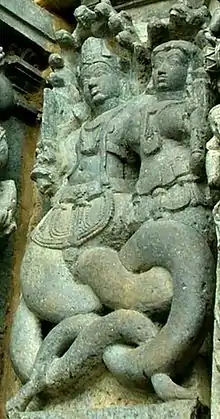

In some regions of the country milk is offered along with crystallized sugar, rice pudding. A special feature is of offering a lotus flower which is placed in a silver bowl. In front of this bowl, a rangoli (coloured design pattern) of snake is created on the floor with a brush made of wood or clay or silver or gold with sandalwood or turmeric paste as the paint. The design pattern will resemble a five hooded snake. Devotees then offer worship to this image on the floor. In villages, the anthills where the snakes are thought to reside, are searched. Incense is offered to the anthill as prayer along with milk (a myth of folk lore to feed milk to the snakes) to ensnare snakes to come out of the anthill. After this, milk is poured into the hole in the anthill as a libation to the snake god.[13]
On this occasion doorways and walls outside the house are painted with pictures of snakes, auspicious mantras (spells) are also written on them. It is believed that such depictions will ward off poisonous snakes.[13]
Naga Panchami is also the occasion observed as Bhratru Panchami when women with brothers worship snakes and its holes, and offer prayers to propitiate nagas so that their brothers are protected and do not suffer or die due to snake bite.[10]
Naga Panchami is also celebrated as Vishari Puja or Bishari Puja in some parts of the country and Bisha or Visha means "poison".[15]
Folktales
Apart from the scriptural mention about snakes and the festival, there are also many folktales. One such tale is of a farmer living in a village. He had two sons and one of whom killed three snakes during ploughing operations.[16] The mother of the snake took revenge on the same night by biting the farmer, his wife and two children and they all died. Next day Mr farmer's only surviving daughter, distraught and grieved by the death of her parents and brothers, pleaded before the mother snake with an offering of a bowl of milk and requested for forgiveness and to restore the life of her parents and brothers. Pleased with this offering the snake pardoned them and restored the farmer and his family to life.[17]
In folklore, snakes also refer to the rainy season - the varsha ritu in Sanskrit. They are also depicted as deities of ponds and rivers and are said to be the embodiment of water as they spring out of their holes, like a spring of water.[18]
Regional traditions

As it is believed that snakes have more powers than humans and on account of its association with Shiva, Devi, Vishnu and Subramanya, a degree of fear is instilled resulting in deification of the cobra and its worship throughout the country by Hindus.[15]
Snake has connotation with the Moon’s nodes known in Hindu astrology. The head of the snake is represented by Rahu ("Dragon's head") and its tail by Ketu ("Dragon's tail"). If in the zodiacal chart of an individual all the seven major planets are hemmed between Rahu and Ketu in the reverse order (anticlockwise) it is said to denote Kalasarpa dosha (Defect due to black snakes), which forebodes ill luck and hardship in an individual's life and therefore appeased by offering worship to the snakes on Naga Panchami day.[3]
Central India
In Central India, in Nagpur, Maharashtra State snakes have special identity. The name of the city is derived from the word Naga which means snake as the place was infested with snakes. Nagpur was the homeland of 'Naga' people who embraced Buddhism, supported it with great efforts in its early period, and propagated it throughout India. Nagoba Temple in Mahal is where worship is offered on Naga Panchami day; the temple was found under the neem tree known as “Nagoba ka vota", under a platform. Another important event held on this occasion is an arduous trekking pilgrimage known as Nagdwar Yatra to Pachmarhi. On this occasion food prepared as offering to the snake god is cooked in a kadai.[3]
Nag Chandreshwar Ujjain
This is a sub temple located in the third floor of Mahakaleshwar Jyotirlinga temple in Ujjain. The speciality of this shrine is it is open only one day of the year on Nag Panchami day and remains shut on the rest of the year. The murthy of Nagchandreshwar is very unique with Shiva and Parvati seated on ten hooded snake surrounded by Nandhi Ganesha and other murthies. It is believed that the great snake Taksha lives here and praying during Nag Panchami rids the devotee of various afflications and doshas such as Nag Dosha, Sarpa Dosha and any form of Doshas.[19]
North and Northwestern India
Nag Panchami is celebrated all over North India. In Kashmir, from historical times snakes have been worshipped by Hindus, and the places of worship are reported as 700.[20][21]
In north western India, in cities such as Benares, it is the time when Akharas (venues of wrestling practice and competitions) as part of Naga Panchami celebrations are bedecked; on this occasion the ahkaras are cleaned up thoroughly and walls painted with images of snakes, priests preside, and the gurus are honoured along with the sponsors. Its significance is that the wrestlers stand for virility and Naga symbolizes this “scheme of virility”.[22] Akharas are decorated with snake images showing snakes drinking milk.[17]
In Narasinghgarh akhara in Varanasi there is special shrine dedicated to Nag Raja (King of Snakes) where a bowl is suspended above the image of the snake and milk is poured into it so that it trickle over the snake god as a form of an offering.[23]
On this day snake charmers are everywhere in towns and villages displaying snakes in their baskets which will have all types of snakes such as pythons, rat snakes, and cobras mingled together. Some of the snake charmers hang limp snakes around their neck and crowds gather to witness these scenes. The snakes in the basket are also worshipped on the occasion.[24]
However, in Punjab this festival is celebrated in a different month and in a different format, in the month of Bhadra (September–October) and is called Guga Nauvami (ninth day of lunar month during bright half of Moon). On this occasion an image of snake is made with dough and kept in a “winnowing basket” and taken round the village. Villagers offer flour and butter as oblation to the image. At the end of the parade, the snake is formally buried and women worship the snake for nine days and give offering of curds.[15]
Western India
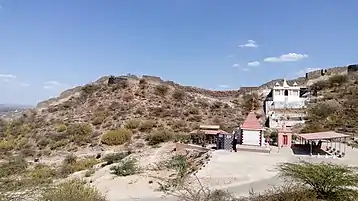
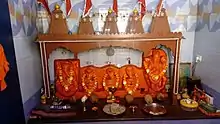
As in the rest of the country, the Naga Panchmi is celebrated in Western India and is known as the Ketarpal or Kshetrapal, meaning, a protector of his domain.[25]
In this part of the country, snake is named Bhujang, which is also the Sanskrit name for snake, in the Kutch region. The name is attributed to the city of Bhuj which is located below the hill named Bhujiya, after Bhujang, as it was the abode of snakes. On top of this hill there is a fort known as the Bhujia Fort where a temple has been built for the snake god and a second temple is at the foot of the hill known as Nani Devi.[25] Bhujia Fort was the scene of a major battle between Deshalji I, the ruler of Kutch and Sher Buland Khan, Mughal Viceroy of Gujarat who had invaded Kutch. It was the early period of Deshalji's reign. When the army of Kutch was in a state of losing the battle, a group of Naga Bawas opened the gate of Bhujia Fort by a clever ploy of visiting Nag temple for worship and joined the fray against Sher Buland Khan's army. Eventually Deshalji I won the battle. Since that day Naga Bawa and their leader have a pride of place in the procession held on Nag Panchami day.[25] Within the fort, at one corner, there is a small square tower dedicated to Bhujang Nag (snake god), who in folklore is said to have been the brother of Sheshnag. It is said Bhujang Nag came from Than of Kathiawar and freed Kutch from the oppression of demons known as daityas and rakshasas.[25] The Snake Temple was also built at the time of the fortification of the hill during Deshalji I's reign and provided with a chhatri. Every year on Nag Panchami day a fair is held at the temple premises. In the Sindhi community Nag Panchami is celebrated in honour of Gogro.
Eastern and Northeastern India
In eastern and north eastern States of India such as West Bengal, Orissa and Assam, the goddess is worshipped as Manasa. According to the Hindu mythology, Manasa is a snake goddess who was also called Jaratkaru and wife of Brahmin sage also named Jaratkaru. On this occasion, sh twig of manasa so sale plant (euphorbia lingularum) symbolizing the goddess Manasa is fixed on the ground and worshipped, not only in the month of Shravan, as in the rest of the country, but also in the month Bhadra Masa. Festival is held within the precincts of the house.[15]
South India

In South India, snake is identified with Subramanya (Commander of the celestial army) and also with Shiva and Vishnu.[15]
In Karnataka, the preparation for the festival starts on the New Moon day of Bhimana Amavasya, five days prior to the festival day of Panchami. Girls offer prayers to the images made out of white clay painted with white dots. They take a vow by tying a thread dipped in turmeric paste on their right wrist and offer prayers. An image of snake is drawn on the floor in front of the house and milk is offered as oblation. On the night previous to the festival they keep complete fast or take a salt free diet. After the pooja, a food feast is held.[26]
In South India, both sculpted and live snakes are worshipped. Every village has a serpent deity. It is worshipped as a single snake or nine snakes called Nava Naga but the popular form is of two snakes in the form of an “Eaculapian rod”. Every worshipper in South India worships the anthill where the snakes are reported to reside. Women decorate the anthill with turmeric paste and vermillion and sugar mixed with wheat flour. They bedeck it with flowers with the help of threads tied to wooden frames. In Maharashtra, they go round the anthill in a worship mode five times singing songs in praise of snake gods.[20]
Another form of worship practiced by women, who have no children for various reasons, install stone statues of snakes below the peepal tree and offer worship seeking blessings of the snake god for bestowing them with children. This is done as it is believed snakes represent virility and have the gift of inducing fecundity curing barrenness.[15]
In Coorg in Karnataka, an ancestral platform called noka is installed with rough stones which are believed to be the ancestral incarnation in the form of snakes but they are not necessarily worshipped on Naga Panchami day.[15]
In Kerala, Ezhavas and Nairs are Serpent-worshipers. A shrine is normally established for snake god at the southwest corner of the ancestral house, along with temple for the para-devata. .[15] For Naga Panchami day, Women fast the previous day. They then on the Naga Panchami Day, take bath at dawn and pray at the tharavad Sarpa kavu. They take the Thirtham milk home. A Chembarathi (Hibiscus) flower is dipped in the milk and sprinkled on the brother's back and then do an arthi. Then a thread dipped in turmeric is tied on the right wrist of the brother. After that a feast is served.
Observance in Nepal
The ritual is widely observed in Nepal, particularly for the fight between Garuda and a great serpent.[27] [28]
In the Changu Narayan Temple in Kathmandu, there is statue of Garuda which is said to have been established by Garuda himself and on the Naga Panchami day the image is said to sweat reminiscing his great fight with a giant snake; people collect the sweat and use it for curing leprosy.[28]
References
- https://www.calendarlabs.com/holidays/hindu/nag-panchami.php
- Verma 2000, pp. 37–38.
- "Nag Panchami: A mix of faith and superstition". Times of India. Retrieved 23 August 2013.
- quintdaily (26 July 2017). "Nag Panchami 2017 Wishes With Images – QuintDaily".
- LLP, Adarsh Mobile Applications. "2019 Nag Pancham Puja Date and Time for New Delhi, NCT, India". Drikpanchang. Retrieved 2019-08-20.
- "The Wrestler's Body". publishing.cdlib.org. Retrieved 2019-08-20.
- "The Mahabharata, Book 1: Adi Parva: Adivansavatarana Parva: Section LX". www.sacred-texts.com. Retrieved 2019-08-20.
- Garg 1992, p. 743.
- "What is the significance of milk in Nag Panchami - Times of India". The Times of India. Retrieved 2020-07-11.
- Verma 2000, pp. 37-38.
- "The Mahabharata, Book 1: Adi Parva: Astika Parva: Section XVI". www.sacred-texts.com. Retrieved 2019-08-20.
- Ago, Aayuin #culture • 3 Years (2017-07-27). "Naag Panchami : A festival of serpents". Steemit. Retrieved 2020-07-23.
- Alter 1992, pp. 137-138.
- "The NAGA and the Nav Naga Stotra". maré hieronimus | Dance Art | The Sacred Body. Retrieved 2019-08-20.
- Sharma 2008, pp. 68-70.
- Aug 2, TNN |; 2014; Ist, 08:28. "Nag Panchami celebrated with customary worship of snakes | Kanpur News - Times of India". The Times of India. Retrieved 2020-07-24.CS1 maint: numeric names: authors list (link)
- Alter 1992, p. 138.
- Alter 1992, p. 143.
- "Nag Panchami 2019: सिर्फ नाग पंचमी को खुलता है यह मंदिर, पूजा के समय स्वयं उपस्थित रहते हैं नागराज तक्षक". Dainik Jagran (in Hindi). Retrieved 2020-07-13.
- Balfour 1885, p. 577.
- "Worshipping Snakes- The Nag Panchami Festival". Zee News. 2017-07-27. Retrieved 2020-07-14.
- Alter 1992, p. 136.
- Alter 1992, pp. 139-140.
- Alter 1992, p. 137.
- Dilipsinh 2004, p. 38.
- Jagannathan 2005, p. 91.
- Claus, Diamond & Mills 2003, p. 689.
- Brockman 2011, p. 93.
- Bibliography
- Alter, Joseph S. (1992). The Wrestler's Body: Identity and Ideology in North India. University of California Press. ISBN 978-0-520-91217-5.
- Balfour, Edward (1885). The Cyclopædia of India and of Eastern and Southern Asia, Commercial Industrial, and Scientific: Products of the Mineral, Vegetable, and Animal Kingdoms, Useful Arts and Manufactures. Bernard Quaritch. p. 577.
- Brockman, Norbert (13 September 2011). Encyclopedia of Sacred Places. ABC-CLIO. ISBN 978-1-59884-655-3.
- Claus, Peter J.; Diamond, Sarah; Mills, Margaret Ann (2003). South Asian Folklore: An Encyclopedia : Afghanistan, Bangladesh, India, Nepal, Pakistan, Sri Lanka. Routledge. ISBN 978-0-415-93919-5.
- Dallapiccola, A. L. (November 2003). Hindu Myths. University of Texas Press. ISBN 978-0-292-70233-2.
- Dilipsinh, K. S. (1 January 2004). Kutch in Festival and Custom. Har-Anand Publications. ISBN 978-81-241-0998-4.
- Garg, Gaṅgā Rām (1992). Encyclopaedia of the Hindu World. Concept Publishing Company. ISBN 978-81-7022-376-4. Retrieved 2 August 2013.
- Jagannathan, Maithily (1 January 2005). South Indian Hindu Festivals and Traditions. Abhinav Publications. ISBN 978-81-7017-415-8.
- Sharma, Usha (1 January 2008). Festivals In Indian Society (2 Vols. Set). Mittal Publications. ISBN 978-81-8324-113-7.
- Verma, Manish (2000). Fasts & Festivals Of India. Diamond Pocket Books (P) Ltd. ISBN 978-81-7182-076-4.
Further reading
- Dictionary of Hindu Lore and Legend (ISBN 0-500-51088-1) by Anna Dhallapiccola
